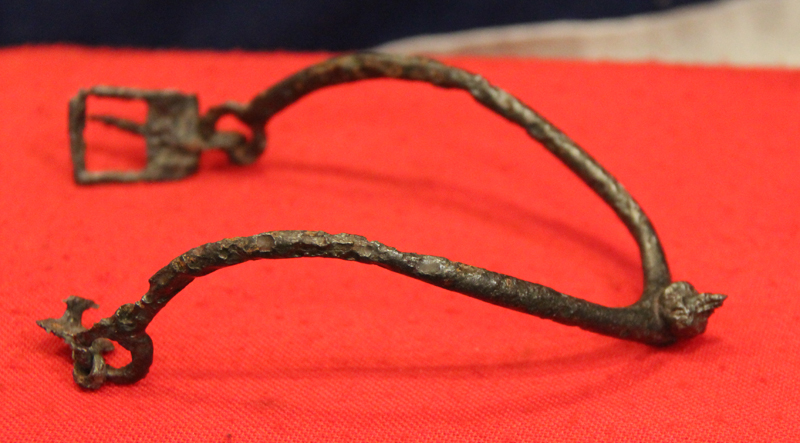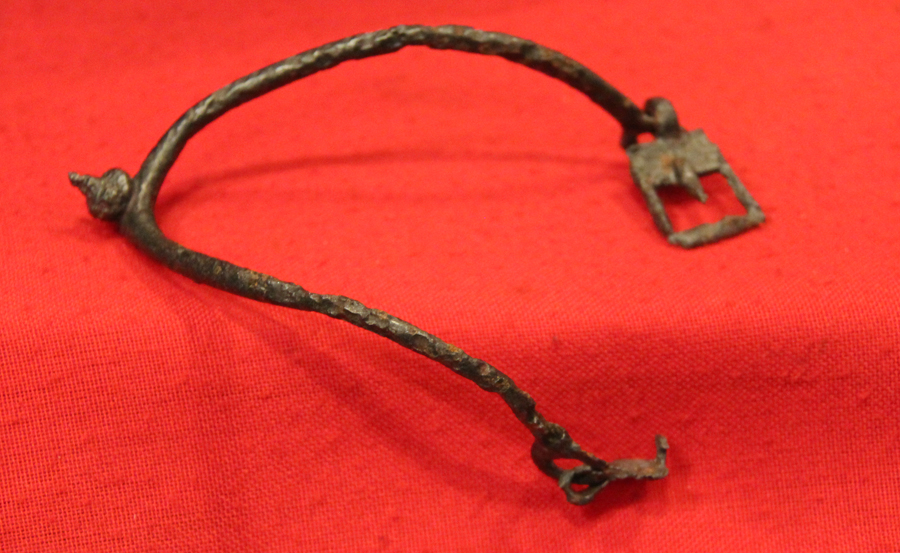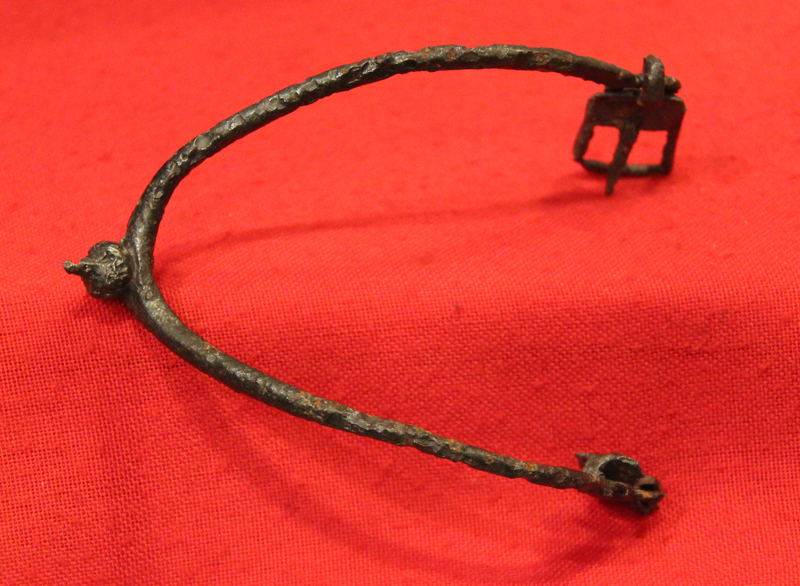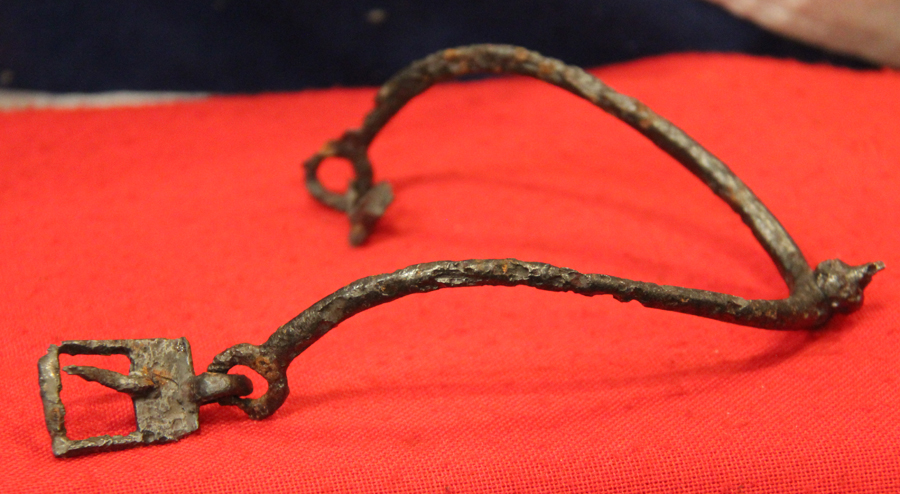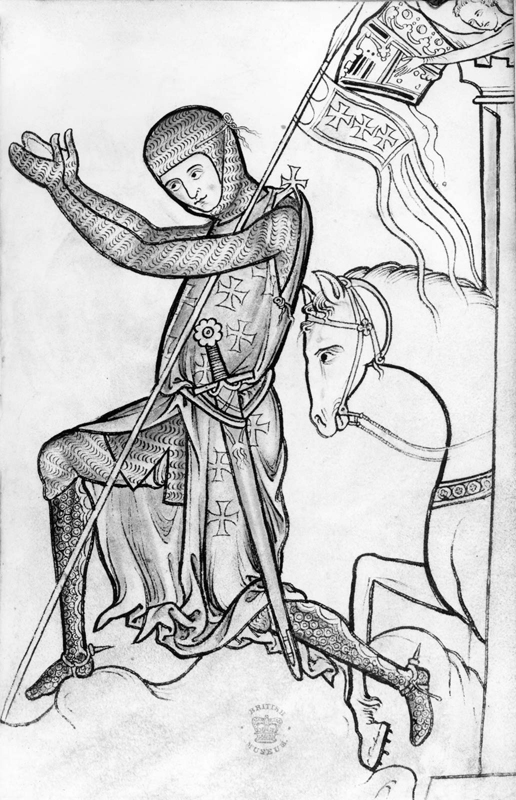A 1200’s Old Knight's Prick Spur, Still With Buckle From The IInd Baron’s War of Henry IIIrd and Earl Simon de Montfort
We show a medeavil drawing from the British Museum of a kneeling knight wearing the very same form of prick spur. It is absolutely remarkable that this spur stil has its leather strap buckle and mount in place. Battle of Lewes period, from the IInd Baron’s War
The Battle of Lewes was one of two main battles of the conflict known as the Second Barons' War. It took place at Lewes in Sussex, on 14 May 1264.[1] It marked the high point of the career of Simon de Montfort, 6th Earl of Leicester, and made him the "uncrowned King of England". Henry III left the safety of Lewes Castle and St. Pancras Priory to engage the barons in battle and was initially successful, his son Prince Edward routing part of the baronial army with a cavalry charge. However, Edward pursued his quarry off the battlefield and left Henry's men exposed. Henry was forced to launch an infantry attack up Offham Hill where he was defeated by the barons' men defending the hilltop. The royalists fled back to the castle and priory and the King was forced to sign the Mise of Lewes, ceding many of his powers to Montfort.
The battle site is still not completely agreed upon, but part of the conflict was recorded at Offham hill, and this is was just 4 miles south of our farm, Thousands of the protagonists soldiers were supposedly camped within our old grounds, but at present it is not certain for which side they fought. Our farm was originally part of Earl Godwin’s estate, later more famously known as King Harold, who also supposedly camped here before his Battle of Hastings in 1066. A Canadian funded documentary is being filmed here at the current time.
Simon de Montfort, 6th Earl of Leicester (c. 1208 – 4 August 1265), later sometimes referred to as Simon de Montfort to distinguish him from his namesake relatives, was a nobleman of French origin and a member of the English peerage, who led the baronial opposition to the rule of King Henry III of England, culminating in the Second Barons' War. Following his initial victories over royal forces, he became de facto ruler of the country, and played a major role in the constitutional development of England.
During his rule, Montfort called two famous parliaments: the Oxford Parliament stripped Henry of his unlimited authority, while the second included ordinary citizens from the towns. For this reason, Montfort is regarded today as one of the progenitors of modern parliamentary democracy, however during his time as Earl of Leicester he was also determinedly anti semitic and expelled all of the Jews from that city, yet curiously, Leicester's Jews were allowed to move to the eastern suburbs, which were controlled by Montfort's great-aunt Margaret, Countess of Winchester. But as he became ruler of England he also cancelled debts owed to Jews through violent seizures of records. Montfort's party massacred the Jews of London, Worcester and Derby, killing scores of Jews from Winchester to Lincoln. After a rule of just over a year, Montfort was killed by forces loyal to the king in the Battle of Evesham
de Montfort also had connections to the Albigensian Crusade, which was a crusade against the heretic Cathars, and was immensely popular in northern France because it gave pious warriors an opportunity to win a Crusade indulgence. The Albigensian Crusade, Crusade (1209-29) was called by Pope Innocent III against the Cathari, a dualist religious movement in southern France that the Roman Catholic Church had branded heretical. The war pitted the nobility of staunchly Catholic northern France against that of the south, where the Cathari were tolerated and even enjoyed the support of the nobles. Although the Crusade did not eliminate Catharism, it eventually enabled the French king to establish his authority over the south. During the first season the Crusaders captured Boziers in the heart of Cathar territory and following the instructions of the papal legate who allegedly said, Kill them all. God will know his own, when asked how the Crusaders should distinguish the heretics from true Christians massacred almost the entire population of the city. With the exception of Carcassonne, which held out for a few months, much of the territory of the Albigeois surrendered to the Crusaders. Command of the Crusade was then given to Simon, lord of Montfort and earl of Leicester, who had served during the Fourth Crusade. A man, one can safely say was famed for his deeply held religious prejudices, yet ironically, an exponent of parliamentary democracy.
Code: 22314
475.00 GBP

